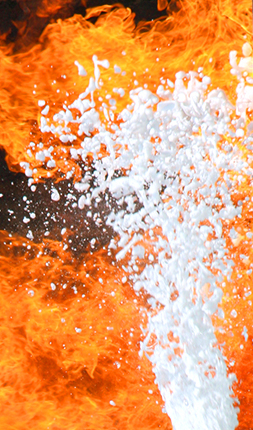Toxic foam limits lowered
 A federal regulator has decreased the acceptable limits for exposure to toxic fire-fighting chemicals.
A federal regulator has decreased the acceptable limits for exposure to toxic fire-fighting chemicals.
The fire-fighting chemicals perfluorooctane sulfonate (PFOS) and perfluoro-octanoic acid (PFOA) are present on a number of sites around Australia, largely due to their former use in training on air force bases.
The federal agency Food Standards Australia and New Zealand used to dictate that the safe level of PFOS in drinking water was 0.5 micrograms per litre, and the safe level of PFOA was 5 micrograms per litre.
But those standards have now changed, with the acceptable level of PFOS per litre in drinking water reduced to less than 0.07 micrograms, and less than 0.56 micrograms per litre of PFOA-contaminated water.
The changes come after more than a year of vocal criticism from people living near old aviation sites. who argued the previous safety level was inadequate, as it allowed exposure levels that were 78 times higher than the limit in the United States.
The change has been welcomed by some, but raises new questions about the validity of all previous studies and data gathered by the Australian Defence Department.
The Health Department has issued a statement saying that just because there are new safe levels, it does not mean the old levels were wrong.
“Both sets of values are precautionary and protective of public health,” the statement read.
“An independent review in August 2016 confirmed that the [former] values, adopted by enHealth [the environmental health standing committee] were appropriate and, as an interim measure, protective of public health.
“The new Australian values take into account the data, parameters and methodology that are most suitable to Australia.”
Hundreds of landholders near the Queensland town of Oakey – where an old Aviation Base has been the source of extensive contamination - have signed up to a class action seeking damages for loss of land value from the Defence Department.
Lawyer Rory Ross, one of the leaders of the class action, said the fact that the exposure limit has been changed is significant.
“They are a validation of the concerns that we and others have expressed about the findings of the Human Health Risk Assessment that was undertaken at Oakey,” he told the ABC.
“The conclusions of that assessment ... I think that's all now undermined.
“It's gut wrenching, I think, for the people of Oakey because they've received assurances from the things the Commonwealth has said and done, that the previous levels were entirely protective.
“Now to say; ‘Well we're actually going to make this an order of magnitude stricter than the interim measures’ ... it's gut wrenching.
“The Department of Defence has to some extent been hiding behind a screen of scientific uncertainty in regard to what does and doesn't constitute an appropriate level in drinking water. I think that screen is now gone.”








 Print
Print